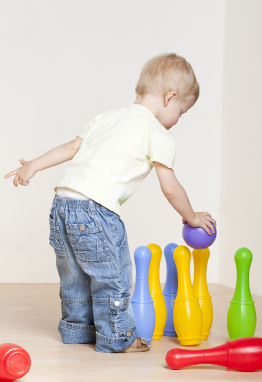Session 4
1. Session 4
1.7. Inquiry 3
Session 4: Providing for Play
Inquiry 3: Stages of Play
Social Stages of Play
Consider the following social stages of play.
|
Social Stages |
Description |
|
Solitary Play |
Children are engaged in this stage of social play when they are playing alone and ignoring those around them. They are very focused on themselves and the objects with which they are playing. Their play is independent of those around them, and they play with different materials than other children in the immediate play area. |
|
Parallel Play |
Parallel play occurs when children are playing side-by-side with similar objects but do not attempt to interact with one other. The children come and go as they please. |
|
Associative Play |
Children engaged in associative play are playing similar activities, but each child is still doing his or her “own thing”; in other words, the children don’t exchange ideas. Each child plays as she or he wants to, but there is some understanding among the children that they are doing the same thing. |
|
Cooperative Play |
In this stage of social play, children who are playing together take turns being the leader and they share roles and exchange rules. For example, they might say, “I’ll be the mommy and you be the baby.” |
|
On-Looking and Unoccupied Play |
Sometimes children stand back and watch something of interest to them. On-looking play occurs when a child spends time watching other children play. Unoccupied play occurs when a child spends time in a variety of non-play behaviours. |
Creative Stages of Play
There are three stages of creative play: basic exploration, non-representative, and representative. In other words, at different creative stages, the same toy may be an object to be explored, an object to be manipulated without an understanding of its purpose, or an object with a specific purpose.
When children learn a new way to play, they may still engage in earlier stages of play. The following chart identifies the ways children play at different ages.
A child’s level of development influences the way the child plays. Children can engage in solitary play in all age groups; however, it is not until age three or four that children begin to participate in cooperative play.
|
Social Stages of Play |
Creative Stages of Play (How Children Use Materials) |
||
|
Basic Exploration |
Non-Representative |
Representative |
|
|
Solitary Play
|
Infants
A baby might use a rattle by sucking on it.
|
Toddlers
A toddler might use the rattle to hit another toy.
|
Toddlers
A two- or three-year-old might shake the rattle to the beat of a song he or she is singing.
|
|
Parallel Play |
Toddlers
Two toddlers might each (but separately) leave a trail of blocks, as Hansel and Gretel did, so that they can find their way back to the swings.
|
Toddlers
Two toddlers might play beside each other as they organize blocks into rows.
|
Younger Preschoolers
Two young preschoolers sit side-by-side as they each build their own tall towers.
|
|
Group Play (Associative and Cooperative Play)
|
Preschoolers
A small group of four- and five-year-old preschoolers use paintbrushes as drumsticks while they play drums together like members of a band.
|
Preschoolers
Two four- and five-year-old preschoolers use paintbrushes and, together, paint a picture of their houses and families.
|
|
Consider the following characteristics of play by age group:

© PHB.cz/28022931/Fotolia
Infants
- Infants typically play for short periods of time.
- Infants use their senses to explore by looking, smelling, tasting, banging, moving, listening, and shaking. This is referred to as sensorimotor play.
- Infants play by responding to social interactions; for example, by cooing, smiling, and laughing.
Toddlers
- Toddlers typically pretend-play with objects such as toy cups, spoons, and dolls. They like to play with adults, pretending to feed others, or pretending to talk on the phone.
- Toddlers like to use “pretend” objects as long as they are similar to real objects.
Preschoolers
- Preschoolers like to role-play stories from books and movies.
- Preschoolers enjoy many kinds of play, including associative play.